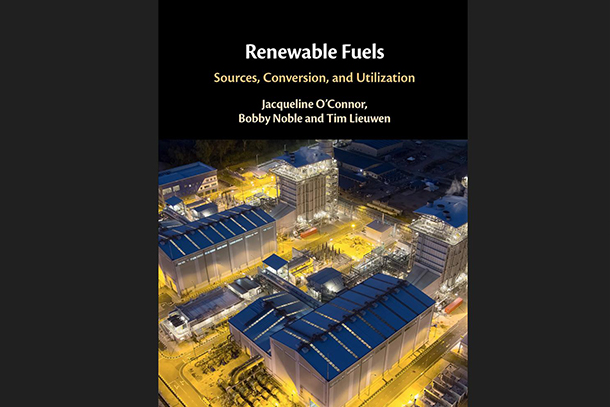
Jacqueline O’Connor, Penn State assistant professor of mechanical engineering, pursues efforts to increase energy efficiency and reduce the climate impact of key technologies like aircraft engines and power generation gas turbines. Credit: Adobe Stock. All Rights Reserved.
Improving understanding, collaboration throughout energy supply chain
December 16, 2022
By Kevin Sliman
Editor’s note: This article originally appeared on Penn State News. Jacqueline O'Connor, assistant professor of mechanical engineering, was featured.
UNIVERSITY PARK, Pa. — Energy literacy, as the U.S. Department of Energy defines it, is "an understanding of the nature and role of energy in the world ... accompanied by the ability to apply this understanding to ... solve problems." Furthermore, according to Jacqueline O’Connor, assistant professor of mechanical engineering at Penn State, energy literacy is crucial during an energy transition, which is the process of replacing fossil fuels with low- or no-carbon energy sources.
O’Connor recently collaborated with colleagues to edit a book titled Renewable Fuels: Sources, Conversion, and Utilization (Cambridge Press, December 2022). Through the book, O’Connor and her co-editors — Timothy Lieuwen, Regents' Professor, David S. Lewis, Jr. Chair and the executive director of the Strategic Energy Institute at Georgia Tech; and Bobby Noble, Electric Power Research Institute Gas Turbine Programs Manager — aim to increase energy literacy and bridge the disconnect between those who make fuels and those who use them. The book features contributing authors from around the world, including some Penn State researchers.
“We wanted to put together the book in such a way that people from all different parts of the energy landscape could approach the book,” O’Connor said. “Additionally, the book can be a catalyst to continue the crucial discussion around fuel, machines and supply chain.”
Through her research in engine combustion and teaching in Penn State’s Department of Mechanical Engineering, O'Connor has pursued efforts to increase energy efficiency and reduce the climate impact of key technologies like aircraft engines and power generation gas turbines. In this pursuit, she said, she has noticed knowledge gaps in the energy supply chain that could stymie an efficient energy transition. The supply chain, in this case, primarily refers to fuel procurement, conversion and combustion as well as the infrastructure and equipment that support those efforts.
“I've always been motivated to study engine combustion because that's the source of the emissions problem,” said O’Connor, whose research has provided her the opportunity to work with a wide range of fuels. “As the world looks to decarbonize, we must think about alternative fuels for the electricity grid and other hard-to-decarbonize technologies that we will be using for many decades to come.”
O’Connor is also the director of the Center for Gas Turbine Research, Education, and Outreach, which is a collection of researchers working on gas turbines for aircraft and land-based systems for power generation and industrial uses.
“During my time working in this field, my colleagues and I have recognized that there are engine and industry people and there are the people who make fuel products,” she said. “Moreover, we’ve observed a significant disconnect between those two communities.”
O’Connor said that disconnect is troubling.
“If you want to solve this energy and climate crisis quickly, communication between all parts of the energy supply chain is essential, and it can't just go one way,” O’Connor said. “People who make fuels can't simply come up with what they think the best fuel is and then pass it off to the people who must use it, because these machines are extraordinarily complex. Similarly, engine folks must be aware of the significant challenges in synthesizing fuels at a large scale.”
She provided an example of fuel for an aircraft engine, which performs numerous functions besides burning, including as a hydraulic fluid and coolant.
“Everyone in the supply chain must be thinking about the machines that are using these fuels, specifically the challenges,” she said. “In addition to engineering, constraints can include regulations, durability, safety and economics.”
When considering these trade-offs, O’Connor said it is challenging because the details in these situations have massive repercussions for energy and the technology using it.
Increasingly, O'Connor's conversations include the topic of switching from fuels to electricity.
“Some people talk about decarbonization like it's a straight, monotonic path from fuels to electrons and that electrons are the solution,” she said. “I think neither of those things are true.”
She points to the role of natural gas as a bridge fuel for electricity generation.

Book cover of "Renewable Fuels: Sources, Conversion, and Utilization" used with permission of Cambridge Press. Credit: General Electric Power. All Rights Reserved.
"We went from burning a lot of coal — almost half of our electricity production in the United States — to now we're at about 20% coal and 40% natural gas. That has cut our carbon output from electricity production in half, which is incredible,” she said. “When we hear the language around decarbonization, often the next thing somebody will say is that we need to reduce our dependence on fossil fuels or completely electrify everything. My heart just sinks every time somebody says we're going to electrify everything because I don't know where that electricity is going to come from."
She added that she is familiar enough with many of these fuel-based technologies, like for aviation and shipping, to know that electrification is not the solution.
New fuels can help in areas such as aircraft, transportation, shipping and dispatchable power, according to O'Connor.
“I think we laid out a strong argument in the book for the necessity of fuels for decades, if not centuries, into the future,” she said. “For researchers like me, this is when we must work across disciplines to identify new molecules that can lead us into a climate-friendly fuel future.”
O’Connor said she was grateful for the opportunity to work with the book’s contributing authors.
“They were fantastic, and their work was incredible,” she said. “I've read this book countless times, and each time it was fun, and I learned so much. My two co-editors are some of my favorite colleagues to work with. It was a lot of work, but it was a labor of love, and I was very fortunate to work on it with the people that I did."
In this video, Penn State engineers including Jacqueline O'Connor advocate for new ways to facilitate a global conversation about energy consumption, including how much energy is being used, the fuel sources that generate electricity and how different parts of the world can reduce its carbon footprint. Credit: Penn State College of Engineering.



